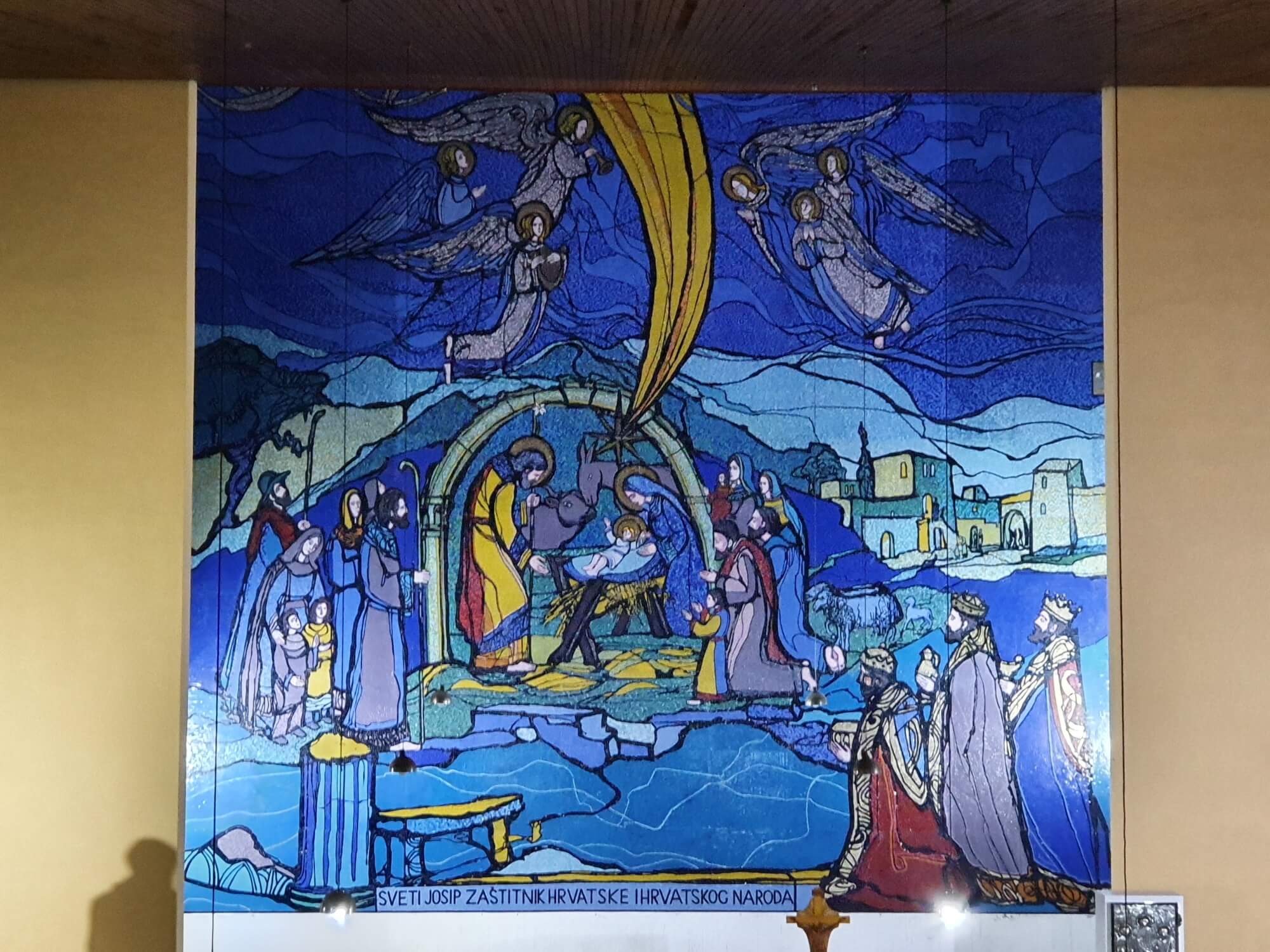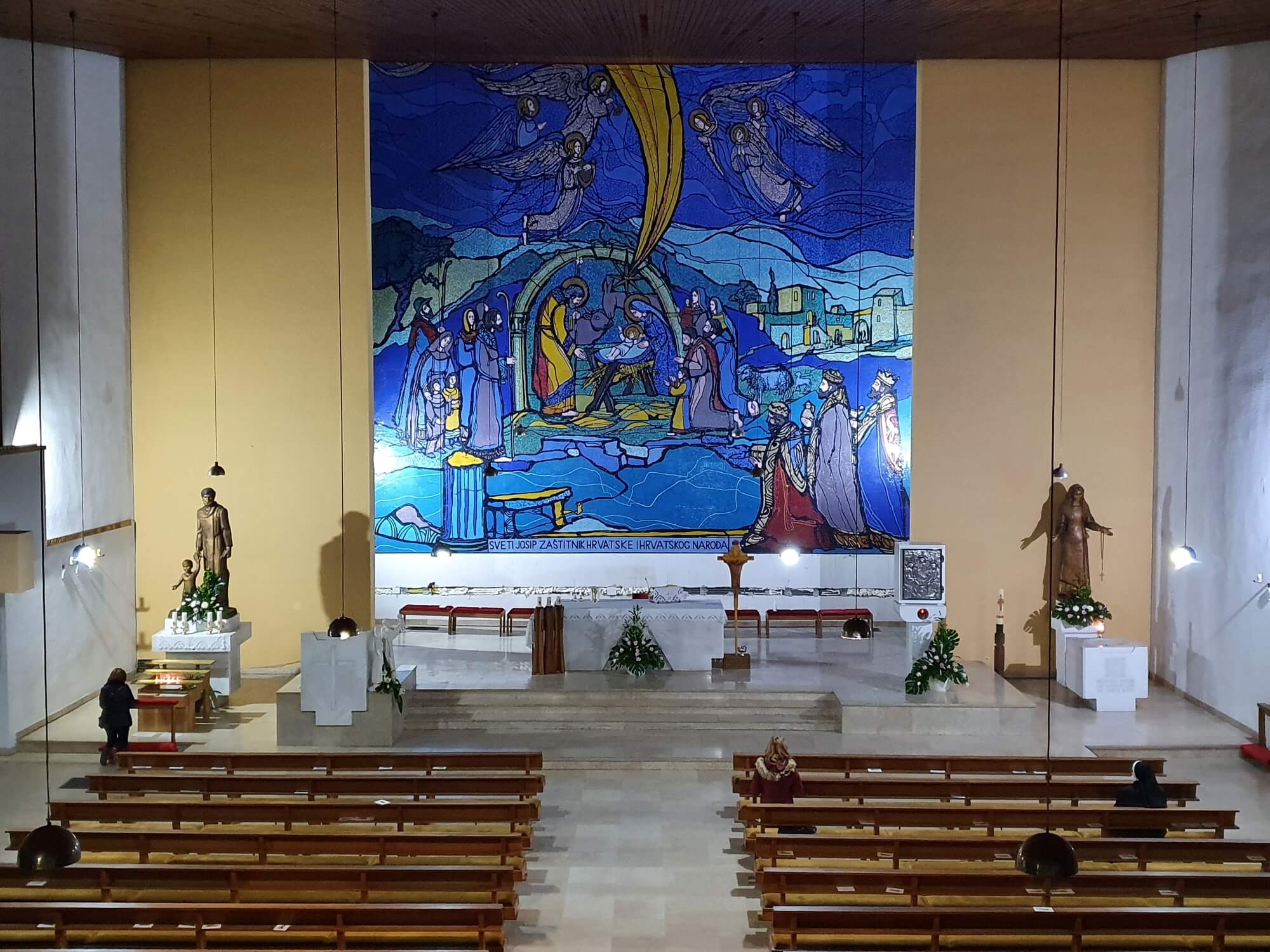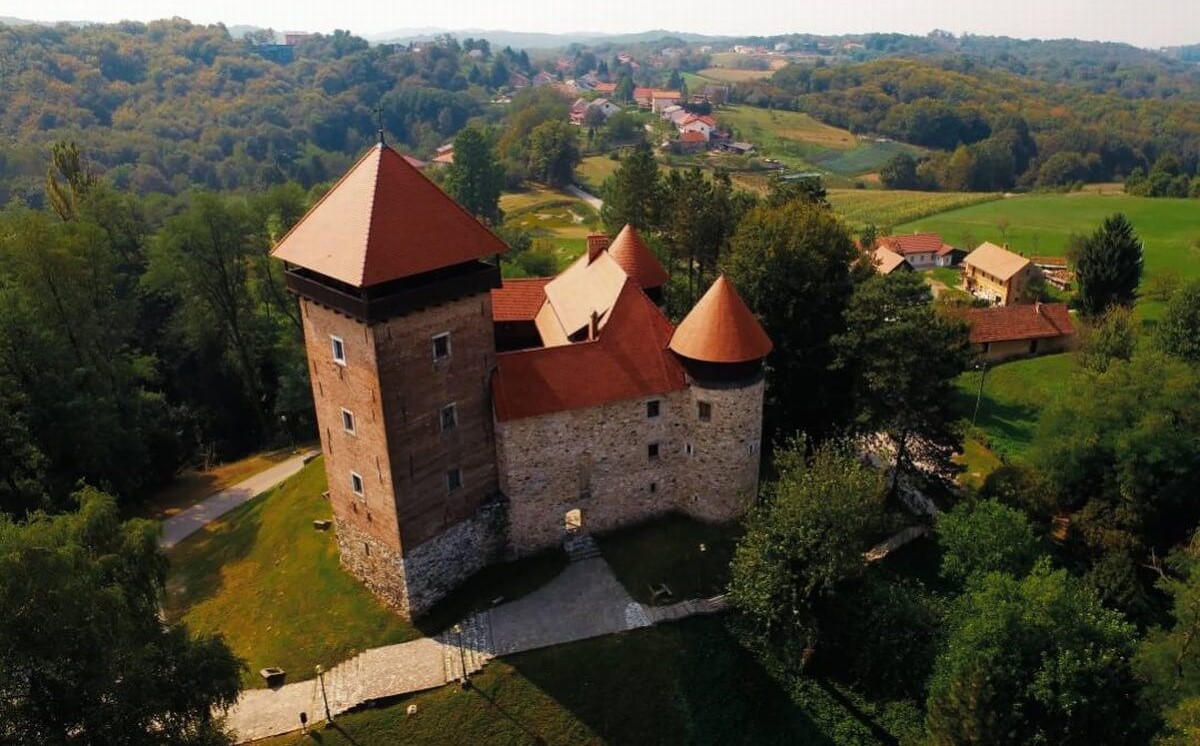Orthodox Fresco Depicting Blessed Stepinac in Hell Painted Over by White
ZAGREB, 22 Jan 2022 - An icon, which appeared in a Serb Orthodox Church in the town of Bela Crkva, Vojvodina, depicting the Blessed Alojzije Stepinac, a Catholic martyr, in the hell, has been painted over by white, the Croatian Catholic news agency IKA reported on Friday.
IKA quoted the Zrenjanin Catholic Bishop Ladislav Német as saying that the controversial icon was painted over by white and that news items about Bela Crkva and the icon depicting Stepinac in the hell were no longer topical.
The news about the controversial fresco was broken by the direktno.hr news website on 16 January. The fresco depicting the hell and the Blessed Stepinac in it was painted on a wall of the Serb Orthodox Church of Saint John in Bela Crkva, a town in the region of Banat, which is in the eastern parts of the Serbian province of Vojvodina.
The whole case prompted the Catholic Archbishop of Belgrade, Stanislav Hočevar, to say that depicting a saint in the hell was an insult to God.
He told the Croatian national broadcaster (HRT) that he would try to solve this issue through dialogue.
He also apologised to the Catholic faithful in Croatia for the belated reaction of the Catholic Church in Vojvodina and Serbia to this case.
Archbishop Hočevar said that this would be also a topic of his talks with the Apostolic Nuncio in Serbia on Saturday.
Pope John Paul II declared Alojzije Stepinac a martyr and beatified him at a ceremony in the Croatian Marian shrine of Marija Bistrica in 1998, when hundreds of thousands of Croatians gathered for that mass.
Later, Pope Francis decided to initiate the establishment of a joint commission to study the historical truth on Croatian Cardinal Alojzije Stepinac and to shed light on the historical role of this Zagreb Archbishop at the time of the WWII Independent State of Croatia (NDH) and the Ustasha crimes in the Jasenovac concentration camp, before the decision on his canonisation.
After the Second World War, Stepinac was persecuted by the Communist authorities in the Tito-led Yugoslavia. In 1945 he declined Tito's proposal to establish a national Catholic church separate from Rome.
In July 2016, Zagreb County Court annulled the Communist-era rulings against Zagreb Archbishop Alojzije Stepinac, who was sentenced in 1946 to 16 years in prison and forced labour and was stripped of his political and civil rights for five years.
Zagreb County Court established that the guilty verdict had grossly violated the then and the current principles of the criminal law.
Cardinal Stepinac (1898-1960) was the leading person of the Catholic Church in Croatia during World War Two. After the war, Communist authorities charged him with collaborating with the Ustasha regime of the Independent State of Croatia (1941-1945), although he publicly denounced the crimes of the pro-Nazi regime and actively helped provide sanctuary for those persecuted. Subsequently, Stepinac spent five years in prison and nine years under house arrest until he died.
In October 1946 the then Supreme Court found him guilty of all charges in his indictment.
In February 1992, the Croatian parliament adopted the declaration condemning the court decision and the process that led to it. The declaration states that the true reason of Stepinac's imprisonment was his pointing out many Communist crimes and especially refusing to form a Croatian Catholic Church in schism with the Pope.
For more, check out our dedicated politics section.
Largest Church Mosaic in Croatia Unveiled in Karlovac
November 13, 2021 – After many years of preparation and effort, the largest church mosaic in Croatia has been revealed to parishioners at the Church of Saint Joseph (Crkva sv. Josip) in Karlovac
The beautiful mosaic covers an incredible 120 square metres of wall behind the church's altar. Depicted in the mosaic is the birth of Jesus Christ.
The mosaic is the work of renowned Croatian artist Josip Botteri Dini who is based in Split. On 1st January 2021, Mr Josip Botteri Dini and several assistants began stacking coloured glass pieces into one-square-metre templates to construct the work.
 Largest Church Mosaic in Croatia © Marina Buric / Visit Karlovac
Largest Church Mosaic in Croatia © Marina Buric / Visit Karlovac
Each template contains around 2500 mosaic parts. In total, the mosaic has around half a million pieces of coloured glass. It took Mr. Botteri Dini nine months to finish stacking 168 templates. After completing that long section of the task in Split, he then travelled to Karlovac and continued working there. The installation of the templates onto the wall took two weeks. Subsequently, six weeks of cleaning and aligning of the mosaic followed.
 From the rear of St. Josip's Church © Marina Buric / Visit Karlovac
From the rear of St. Josip's Church © Marina Buric / Visit Karlovac
Josip Botteri Dini, the artist behind the largest church mosaic in Croatia
Although he now lives and works in Split, Josip Botteri Dini was actually born in Zagreb in 1943. He studied at the city's Academy of Fine Arts, notably in the class of famous Varaždin painter and graphic artist Miljenko Stančić. Josip graduated in 1968. Since the early 1970s, the work of Josip Botteri Dini has been exhibited over a hundred times throughout Croatia and overseas. In addition to painting, he works with mosaics and stained glass.
 In detail, Croatia's largest church mosaic, in St. Josip's, Karlovac © Marina Buric / Visit Karlovac
In detail, Croatia's largest church mosaic, in St. Josip's, Karlovac © Marina Buric / Visit Karlovac
Being the largest Church mosaic in Croatia, it was necessary to construct a 13-metre high scaffold for the work to be set on the church wall. Although Mr. Botteri Dini is now 78 years old, he climbed the scaffold every day to finish his work, helped by his brothers Juraj and Dezi. They are also in their seventies.
 Nacionalno svetište svetog Josipa (National Shrine of St. Joseph) in Dubovac, Karlovac
Nacionalno svetište svetog Josipa (National Shrine of St. Joseph) in Dubovac, Karlovac
Nacionalno svetište svetog Josipa (National Shrine of St. Joseph) in Dubovac, Karlovac
Otherwise known as Nacionalno svetište svetog Josipa (National Shrine of St. Joseph), the modern Church of Saint Joseph lies to the west of Karlovac city centre in Dubovac. In fact, it sits at the foot of the hill on which is placed the 13th-century castle fortress Old Town of Dubovac, from where the settlement gets its name.
Construction of the Church of St. Josip started in 1968 but its external facades were not completed until 1972. In 1975 its bell tower was built although it would take until 1980 for three new bells to be placed within it. In 1987, the church was dedicated as a national shrine for Saint Joseph, marking the 300th anniversary of Saint Joseph being assigned as Protector of the Homeland and the Croatian people. Saint Joseph is also the patron saint of Karlovac.
The largest Church mosaic in Croatia is not the only masterpiece to be found in the Church of St. Josip. Within the building is the permanent exhibition space Galeriji 'Martin Borković'. It contains works of art by 28 eminent Croatian painters and sculptors. You can see them every day after Holy Mass.
 The Old Town of Dubovac © Ivo Biočina
The Old Town of Dubovac © Ivo Biočina
The Old Town of Dubovac is one of the best-preserved buildings of its kind in Croatia. A popular tourist attraction, it hosts events and has one of the city's best restaurants on the ground floor of its atmospheric courtyard. With the addition of the largest Church mosaic in Croatia, visitors now have another excellent reason to stop off in the quiet Karlovac suburb of Dubovac.
You can read more about Karlovac in the Total Croatia guide to the city here. For the latest news about Karlovac, be sure to check Total Croatia News tagged pages here
PM Andrej Plenković Extends Kurban Bayram Greetings
ZAGREB, 20 July, 2021 - Prime Minister Andrej Plenković on Tuesday congratulated the head of the Islamic Community in Croatia, Mufti Aziz Hasanović, and all Islamic believers on Kurban Bayram, wishing that the Bayram days be filled with peace, health and joy.
Plenković also wished that "this time of sacrifice give you inspiration and strength to overcome the challenges and tests ahead."
For more about politics in Croatia, follow TCN's dedicated page.
Ivo Pilar Social Research Institute Expanding Scientific Cooperation in Sarajevo (BiH)
July 2, 2021 - Dedication to researching and developing the field of social sciences sees the Ivo Pilar Social Research Institute expanding scientific cooperation once again after Željko Holjevac's visit to Sarajevo, in Bosnia and Herzegovina.
The Ivo Pilar Social Research Institute, active as always, continues to expand its cooperation on scientifically explain social issues (symbolically noted as 2021 marks 30 years of the Institute).
As reported on their official website, Institute headmaster dr. Željko Holjevac visited Sarajevo, the capital city of the neighboring Bosnia and Herzegovina, from June 21-23.
The main story of that visit was a signed bilateral cooperation agreement between the Ivo Pilar Social Research Institute and the Sarajevo Catholic Faculty. The agreement was signed by Holjevac and Faculty dean dr. Darko Tomašević.
Additionally, Holjevac was at the reception with Vrhbosanski's vice bishop Vinko Puljić.
„They talked about possible shared projects that would be adjusted to the tradition, culture and developing needs of Croats in Bosnia and Herzegovina“, informed Ivo pilar social research Institute.
Croatian Cultural Society Napredak (progress) also met with Holjevac. Napredak soon celebrates 120 years of work and was founded at the start of the 20th century when the famous Croatian social scientist Pilar was active in Bosnia and Herzegovina. Napredak plans various manifestations for their big anniversary, and dr. Holjevac discussed the possible cooperation in organizing an international scientific symposium regarding the identity of Croats in Bosnia and Herzegovina.
Ivo Pilar Institute working in full speed
This sort of cooperation in regards to researching the Croatian diaspora in the neighboring country where the Croatian historical role and present is significant is nothing new for the Ivo Pilar Social research Institute.
As TCN reported earlier in May, the Institute, along with scientific partners, organized a conference “Identity of Boka Kotorska Croatians“, and the three-day event gathered crucial scientific institutes in Croatia to the town of Tivat in the Bay of Croatian Saints in Montenegro.
Scientists from the Institute were also active this year as they participated at European Conference For Social Work Research (ECSWR), International Society for Ethnology and Folklore (SIEF) Conference, and also by presenting a book on Croatian Mountain Rescue Service in Gospić, or by presenting book Cultural Identity of Vukovar – Contribution to Investigating Heritage and Successors“ – to list some of the activities TCN reported on throughout 2021.
As 2021 marks the 30th year anniversary of the Ivo Pilar Institute, apart from the aforementioned actions (to which we can include nurturing relations with scientific colleagues in Slovakia or opening a new research office on Vis Island), several more goals were envisioned by the end of the year: to publish the first edition of critical translation for the book „South Slavic (Yugoslav) Question“ by Ivo Pilar from 1918, and to make and publish Pilar's Kaleidoskop of Croatian society.
With the active academic dynamic demonstrated by the Institute, there is no doubt there is enough quality and capacity to achieve these goals. It is only a matter of time in such a busy and productive schedule.
Learn more about Croatian Diaspora on our TC page.
For more about science in Croatia, follow TCN's dedicated page.
President Zoran Milanović, PM Andrej Plenković Issue Separate Messages on Occasion of Ramadan Bayram
ZAGREB, 13 May, 2021 - President Zoran Milanović and Prime Minister Andrej Plenković on Thursday issued separate messages offering their best wishes to Muslims on the occasion of the holiday of Ramadan Bayram.
Wishing all the best to the head of the Islamic Community in Croatia, Mufti Aziz Hasanović and the Muslim community, PM Plenković wished them an abundance of peace, hope and family unity.
Stressing the traditionally good relations between the government and the Islamic Community, Plenković expressed confidence that "our continual dialogue, mutual respect and understanding will contribute to an even better cooperation to the benefit of our society and community."
In his message to Muslims, President Milanović said that he wished the great holiday of sacrifice and self-restraint to serve as an encouragement in the promotion of mutual understanding, dialogue and tolerance to the benefit of Croatia.
"My sincere congratulations to fellow citizens of Muslim faith on the occasion of Ramadan Bayram. May this great holiday of sacrifice and self-restraint bring you peaceful and joyous moments of piety and family unity and serve as encouragement in the promotion of mutual understanding, dialogue and tolerance to the benefit of our homeland," Milanović said in his message.
Parliament Speaker Gordan Jandroković, too, today offered his best wishes to Muslims on the occasion of Ramadan Bayram.
For more about politics in Croatia, follow TCN's dedicated page.
Mosque with Minaret to be Constructed for Dubrovnik's Muslim Community
A brand new building is set to be built down in Dubrovnik as a mosque for the religious needs of almost 1,500 people who identify as Muslims (according to the 2011 census) will be constructed.
As Al Jazeera Balkans writes on the 16th of April, 2019, the Islamic centre which will be located in the Gruž area of the City of Dubrovnik should become a reality in just two years, according to a report from Dubrovacki dnevnik.
As soon as all of the required documentation is dealt with and settled, the construction of the mosque, complete with a minaret, is likely to begin, which is not expected to last for a particularly long time. For now, building permits are being waited on.
The future mosque's location will be at a space on the site of former GP Dubrovnik in Gruž, the project foresees the construction of a mosque complete with a minaret, which will be built in Mediterranean or Moroccan style.
"The project will go its way, it will not take long until we get the construction permit, so we're currently preparing the paperwork, and everything will be ready for construction in two years. We have to emphasise the fact that we in the Islamic community have great cooperation with the city authorities which have been coming to meet with us,'' said the Islamic Community's president, Fehim Vukotić.
The construction of an Islamic center is a long-term desire of Dubrovnik's resident Muslim population, of whom in Dubrovnik, at least according to the census of 2011, there are 1,499. That number has likely risen since then.
By building an Islamic center and a mosque with a minaret, there will finally be a place dedicated to numerous social content and events for the southern Dalmatian city's local Muslim community, as well as prayer rooms.
Make sure to follow our dedicated lifestyle page for much more. If it's just Dubrovnik and the extreme south of Dalmatia you're interested in, give Total Dubrovnik a follow. Need ideas for what to do when visiting the Pearl of the Adriatic, check out Dubrovnik in a Page.
“Catholic Church Will Not Write New Abortion Law”
Shortly after creating a storm by saying that the Church will have representatives in a working group for drafting the new abortion law, the health minister apparently changes his mind.
Incorrupt Body of Saint Leopold Bogdan Mandić: Traffic Regulations in Dubrovnik Over Weekend
Pay special attention to the temporary traffic regulations in Dubrovnik this weekend.
The Fifth Sunday of Lent: The Way of The Cross to Srdj
A warm and sunny Sunday drew many outdoors to partake in the Dubrovnik tradition which takes you to new heights on foot.


